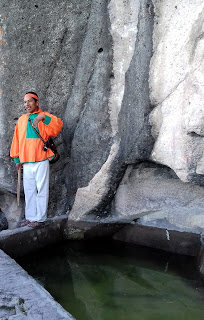The train station at Barrancas is a simple wooden building. There was snow on the ground, something I haven't seen up close for a while. Some Raramuris in the station were selling their baskets.




The view from the dining room of the Hotel slung out over the canyon.

The hotel from below

The hotel from above
Below some views of the Canyon Otero

Houses of some Raramuri set into shallow caves. With this view each and every day it must affect your perspective.


Some say La Barrancas de Cobre get their name from a mistake made by the first Spanish who arrived. The Spanish were so tuned to looking for metals that they mistook the green color from a lichen as an indication that copper was present. Others say the color comes from seasonal light. At times the light is such that the canyons take on a copper hue.
Las Barrancas de Cobre are home to the shy reclusive Tarahumara or Raramuri indigenous people who are related to the Apaches in the north. These natives are famed for their long-distance running ability. Some 50,000 Raramuri ("the people of the swiftly running feet") — as they call themselves — live in caves and other primitive dwellings, much as their ancestors have for centuries.
Horacio, pictured below in an orange shirt described a game played by the Raramuri during Easter Week. The community is broken into groups. Teams make bets of money and clothes that are placed in a pot. This creates incentive. Each group must kick or swat a 4" diameter madroño wood ball with a stick also made of madroño wood over a rough course that traces a 4 kilometer circle,,,,, not just once but 15 times. That's 60 kilometers in a day and in simple sandals. The winning team takes the whole pot. Men race against other all male teams. Women have their own event that uses rings instead of a wooden ball.
The Copper Canyon, or Barrancas del Cobre, is actually a 25,000 square mile system of six interconnected canyons located at the Southwestern part of the state of Chihuahua, Mexico. Four of the six separate canyons are deeper that the Grand Canyon, some by over 1,000 feet. However, the Grand Canyon is larger that any of the individual canyons of the Copper Canyon system.
Urique Canyon - 6136 ft deep
Sinforosa Canyon - 5904 ft deep
Copper Canyon - 5770 ft deep
Tararecua Canyon - 4674 ft deep
Batopilas Canyon - 5904 ft deep
Oteros Canyon - 3225 ft deep
This area has drained the precipitation collected upon these folds in the surface of the earth for millions of years. All the rivers that are formed on this side of the Sierra Tarahumara meet to form the Rio Fuerte which used to empty into the Sea Of Cortez but because of agricultuyral use in Sinaloa just a trickle is left by the time it reaches the ocean.
Like its distant cousin, The Grand Canyon, there is a great differential in temperature between the top and the bottom.During the winter the temperature at the highest point of the canyon stays around the 50 degrees while the temperature at the bottom of the canyon reaches the 80 degrees and higher. Vegetation is also different in the two zones. The highlands are home of Ponderosa pines, madroño, and oak, whereas the bottom is predominately sub-tropical. In fact some of the Raramuri that live up near the rim maintain orchards of mangoes and other fruits at the bottom. It's a three hour walk to bring home the harvest.
The Copper Canyon is a young ditch geologically, perhaps 20-40 million years ago. The Grand canyon formation goes back to the beginning of time practically, but Las Barrancas were formed when volcanic deposits and rippling tectonic folds were further carved by water and more volcanic action.
We spent some time talking to the Raramuri who gathered near the hotel to sell their wares,, or trying to talk to them. Spanish is their second language. After several hours, one young mother named Lorena, and her mother, Naty opened up a little.
 Lorena weaving
Lorena weaving
Raramuri woman weaving

Lorena in the early morning making baskets to sell.

Raramuri woman Lorena weaving
We took a walk below the hotel and met these escuintles. The whole family sells.
 Carmelita
Carmelita Naty
Naty Naty
Naty v
v















No comments:
Post a Comment